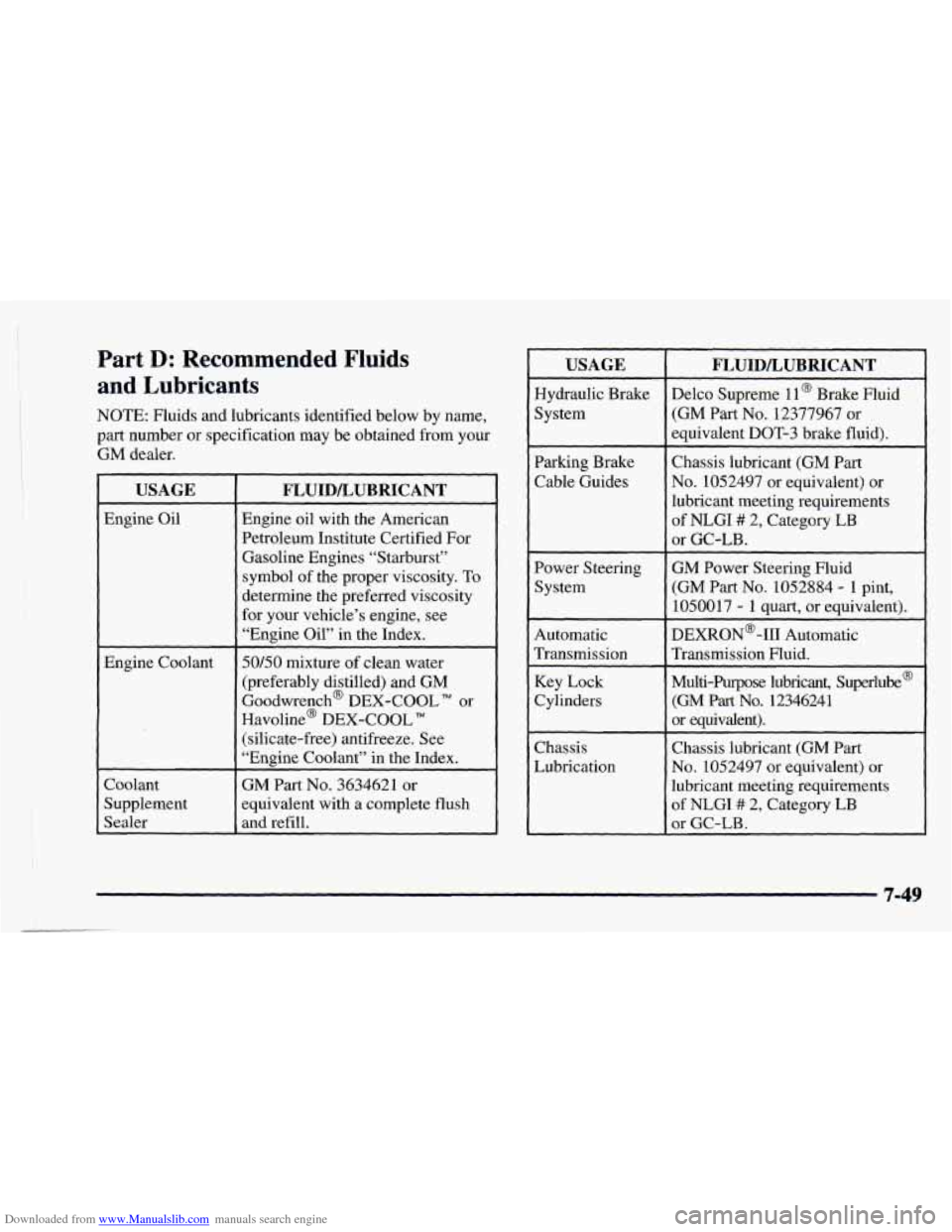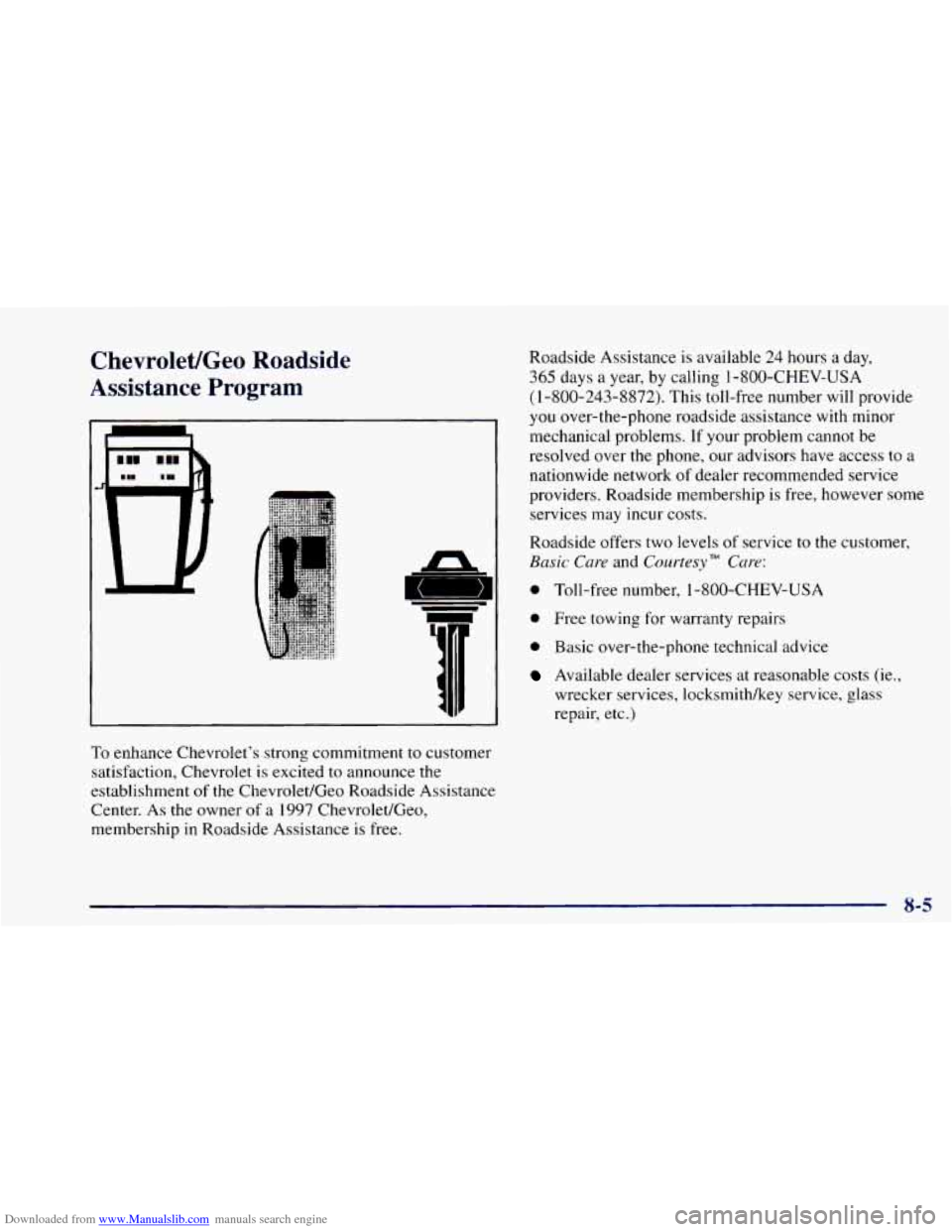1997 CHEVROLET ASTRO lock
[x] Cancel search: lockPage 323 of 404

Downloaded from www.Manualslib.com manuals search engine Crankcase Capacity
Quantity* with Filter ........... 4.5 quarts (4.3 L)
After refill, the level must be checked. Do not overfill.
Fuel Tank Capacity
Standard Tank ................. 25 gallons (90 L)
Transmission Capacity
Automatic Transmission
(Drain and Refill)
.......... 5.0 quarts (4.7 L)
Front Axle Capacity
Front Axle .............. ... 2.6 pint (1.2 L)
Rear Axle Capacity
Standard Rear Axle .............. 3.5 pint (1.7 L)
Locking Rear Axle ............... 3.5 pint (1.7 L)
Air Conditioning Refrigerants
Not all air conditioning refrigerants are the same.
If the air conditioning system in your vehicle needs
refrigerant, be sure
the proper refrigerant is used.
If you’re not sure,
ask your GM dealer.
Refrigerant should be added only by a qualified
A/C technician.
Air Conditioning Refrigerant Capacity
Type System Quantity*
R- 134a C-60** 2 Ibs. (0.91 kg)
R- 134a C-(j9*** 3 lbs. (1.36 kg)
*All quantities are approximate.
**Front A/C only.
***Front and Rear A/C.
I NOTICE:
I
R-134a refrigerant is not compatible with R-12
refrigerant in an air conditioning system. R-12 in
an R-134a system
will cause compressor failure,
refrigerant oil sludge or poor air conditioning
system performance.
6-67
Page 331 of 404

Downloaded from www.Manualslib.com manuals search engine Short TripKity Maintenance Schedule
The services shown in this schedule up to 100,000 miles
( 166 000 km) should be performed after 100,000 miles
(166 000 km) at the same intervals. The services shown
at
150,000 miles (240 000 km) should be performed at
the same interval after
150,000 miles (240 000 km).
See “Owner Checks and Services” and “Periodic
Maintenance Inspections’’ following.
Footnotes
‘f The U.S. Environmental Protection Agency or the
California Air Resources Board has determined that the
failure to perform this maintenance item will not
nullify
the emission warranty or limit recall liability prior to the
completion
of the vehicle’s useful life. We, however,
urge that all recommended maintenance services be
performed at the indicated intervals and the maintenance
be recorded.
# Lubricate the front suspension, ball joints and kingpin
bushings, steering linkage and transfer case shift
linkage, parking brake cable guides, and brake
pedal springs.
+ A good time to check your brakes is during tire
rotation. See “Brake System Inspection’’ under “Periodic
Maintenance Inspection”
in Part C of this schedule.
:%* Drive axle service (see “Recommended Fluids and
Lubricants”
in the Index for proper lubricant to use):
0
0
0
Locking Differential -- Drain fluid and refill at first
engine
oil change. At subsequent oil changes, check
fluid level and add fluid as needed. If driving
in
dusty areas or towing a trailer, drain fluid and refill
every
15,000 miles (25 000 km).
Standard Differential
-- Check fluid level and add
fluid as needed at every oil change. If driving in
dusty areas or towing a trailer, drain fluid and refill
every
15,000 miles (25 000 km).
More frequent lubrication may be required for
heavy-duty use.
7-7
Page 354 of 404

Downloaded from www.Manualslib.com manuals search engine Long TriplHighway Maintenance Schedule I
The services shown in this schedule up to 100,000 miles
( 166 000 km) should be performed after 100,000 miles
(166
000 km) at the same intervals. The services shown
at
150,000 miles (240 000 km) should be performed at
the same interval after 150,000 miles
(240 000 km).
See “Owner Checks and Services” and “Periodic
Maintenance Inspections” following.
Footnotes
The U.S. Environmental Protection Agency or the
California Air Resources Board has determined that the
failure to perform this maintenance item will
not nullify
the emission warranty or limit recall liability prior to
the
completion of the vehicle’s useful life. We, however,
urge that all recommended maintenance services be
performed at the indicated intervals and the maintenance
be recorded.
# Lubricate the front suspension, ball joints and kingpin
bushings, steering linkage and transfer case shift
linkage, parking brake cable guides, and brake
pedal springs.
+ A good time to check your brakes is during tire
rotation. See “Brake System Inspection” under “Periodic
Maintenance Inspections” in Part
C of this schedule.
** Drive axle service (see “Recommended Fluids and
Lubricants” in the Index
for proper lubricant to use):
0 Locking Differential -- Drain fluid and refill at first
engine oil change. At subsequent oil changes, check
fluid level and add fluid as needed.
0 Standard Differential -- Check fluid level and add
fluid as needed at every engine oil change.
7-30
Page 368 of 404

Downloaded from www.Manualslib.com manuals search engine At Least %ice a Year Automatic Transmission Check
Restraint System Check
Make sure the safety belt reminder light and all your
belts, buckles, latch plates, retractors and anchorages are
working properly. If your vehicle has a built-in child
restraint, also periodically make sure the harness straps,
latch plates, buckle, clip, retractors and anchorages are
working properly. Look for
any other loose or damaged
safety belt and built-in child restraint system parts. If
you see anything that might keep a safety belt or built-in
child restraint system from doing its job, have it
repaired. Have any
torn or frayed safety belts or harness
straps replaced.
Also look for any opened or broken air bag covers, and
have them repaired or replaced. (The air bag system
does not need regular maintenance.)
Wiper Blade Check
Inspect wiper blades for wear or cracking. Replace blade
inserts that appear worn
or damaged or that streak or
miss areas of the windshield. Also see “Wiper Blades,
Cleaning” in the Index. Check
the transmission fluid
level; add if needed. See
“Automatic Transmission’’ in the Index.
A fluid loss
may indicate a problem. Check the system and repair
if needed.
At Least Once a Year
Key Lock Cylinders Service
Lubricate the key lock cylinders with the lubricant
specified in
Part D.
Body Lubrication Service
Lubricate all body door hinges, the body hood, fuel
door and rear compartment hinges, latches and locks
including interior glove box and console doors, and any
moving seat hardware. Lubricate the hood safety lever
pivot and prop rod pivot.
Part D tells you what to use.
More frequent lubrication may be required when
exposed to
a corrosive environment.
7-44
Page 369 of 404

Downloaded from www.Manualslib.com manuals search engine Starter Switch Check
I A CAUTION: I
When you are doing this check, the vehicle could
move suddenly. If it does, you or others could be injured. Follow the steps below.
1. Before you start, be sure you have enough room
around the vehicle.
2. Firmly apply both the parking brake (see “Parking
Brake” in the Index if necessary) and the
regular brake.
NOTE: Do not use the accelerator pedal, and be
ready to turn off the engine immediately if
it starts.
3. Try to start the engine in each gear. The starter
should work only in PARK
(P) or NEUTRAL (N).
If the starter works in any other position, your
vehicle needs service.
Brake-Transmission Shift Interlock (BTSI) Check
A CAUTION:
When you are doing this check, the vehicle could
move suddenly.
If it does, you or others could be
injured. Follow the steps below.
1.
2.
3.
Before you start, be sure you have enough room
around the vehicle. It should be parked
on a
level surface.
Firmly apply the parking brake (see “Parking Brake”
in
the Index if necessary).
NOTE: Be ready to apply the regular brake
immediately if
the vehicle begins to move.
With the engine off, turn the key to
the RUN
position, but don’t start the engine. Without applying
the regular brake, try to move the shift lever out
of PARK (P) with normal effort. If the shift lever
moves out
of PARK (P), your vehicle’s BTSI
needs service.
7-45
Page 370 of 404

Downloaded from www.Manualslib.com manuals search engine Ignition Ransmission Lock Check
While parked, and with the parking brake set, try to turn
the ignition key to
LOCK in each shift lever position.
0 The key should turn to LOCK only when the shift
lever
is in PARK (P).
0 The key should come out only in LOCK.
Parking Brake and Automatic Transmission
PARK
(P) Mechanism Check
I A CAUTION: I
When you are doing this check, your vehicle
could begin to move. You or others could be
injured and property could be damaged. Make
sure there is room in front of your vehicle in case
it begins to roll. Be ready to apply the regular
brake
at once should the vehicle begin to move.
Park on a fairly steep hill, with the vehicle facing
downhill. Keeping your foot
on the regular brake,
set the parking brake.
0 To check the parking brake’s holding ability:
With the engine running and transmission
in
NEUTRAL (N), slowly remove foot pressure from
the regular brake pedal.
Do this until the vehicle is
held by the parking brake only.
0 To check the PARK (P) mechanism’s holding ability:
With the engine running, shift to PARK
(P). Then
release all brakes.
7-46
Page 373 of 404

Downloaded from www.Manualslib.com manuals search engine !‘ Part D: Recommended Fluids
and Lubricants
NOTE: Fluids and lubricants identified below by name, part number or specification may be obtained from your
GM dealer.
I USAGE
Engine Coolant
Coolant Supplement
Sealer
FLUIDLUBRICANT
Engine oil with the American
Petroleum Institute Certified For
Gasoline Engines “Starburst”
symbol of the proper viscosity.
To
determine the preferred viscosity
for your vehicle’s engine, see
“Engine Oil” in the Index.
50/50 mixture of clean water
(preferably distilled) and GM
Goodwrench@ DEX-COOL
or
Havoline@ DEX-COOL TM
(silicate-free) antifreeze. See
“Engine Coolant’’ in the Index.
GM Part No. 3634621 or
equivalent with a complete flush
and refill.
-_
USAGE
Delco Supreme 11 @ Brake Fluid Hydraulic Brake
FLUIDLUBRICANT
(GM Part No. 12377967 or System equivalent DOT-3 brake fluid).
Parking Brake Chassis lubricant (GM
Part
Cable Guides No. 1052497 or equivalent) or
lubricant meeting requirements
of NLGI
# 2, Category LB
or GC-LB.
Power Steering
GM Power Steering Fluid
System (GM
Part No. 1052884 - 1 pint,
Automatic DEXRON@-I11 Automatic
Transmission Transmission Fluid.
Key
Lock Multi-Purpose lubricant, Superlube@
Cylinders
(GM Part No. 12346241
or equivalent).
1050017
- 1 quart, or equivalent).
Chassis Chassis lubricant
(GM Part
Lubrication No. 1052497 or equivalent)
or
lubricant meeting requirements
of NLGI # 2, Category LB
or GC-LB.
7-49
Page 381 of 404

Downloaded from www.Manualslib.com manuals search engine Chevrolet/Geo Roadside
Assistance Program
To enhance Chevrolet's strong commitment to customer
satisfaction, Chevrolet is excited to announce the
establishment of the Chevrolet/Geo Roadside Assistance
Center. As
the owner of a 1997 Chevrolet/Geo,
membership
in Roadside Assistance is free. Roadside
Assistance
is available 24 hours a day,
365 days a year, by calling 1-800-CHEV-USA
(1-800-243-8872). This toll-free number will provide
you over-the-phone roadside assistance with minor
mechanical problems.
If your problem cannot be
resolved over the phone, our advisors have access to a
nationwide network
of dealer recommended service
providers. Roadside membership is free, however some
services may incur costs.
Roadside offers two levels
of service to the customer,
Basic Care and Courtesy" Cure:
0 Toll-free number, 1-800-CHEV-USA
e Free towing for warranty repairs
0 Basic over-the-phone technical advice
Available dealer services at reasonable costs (ie.,
wrecker services, locksmith/key service, glass
repair, etc.)